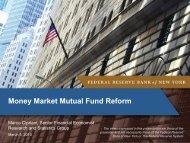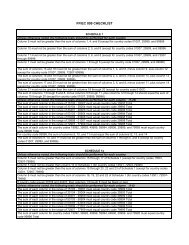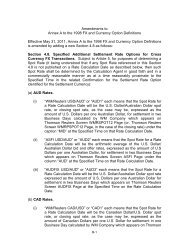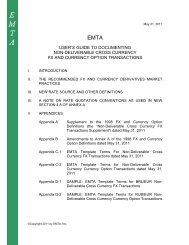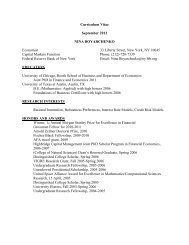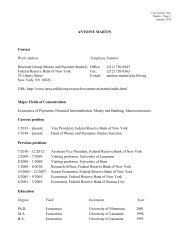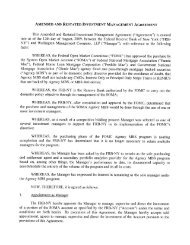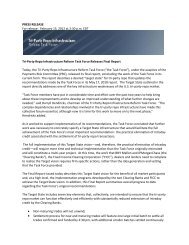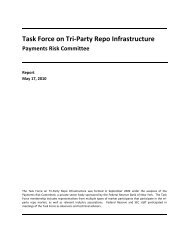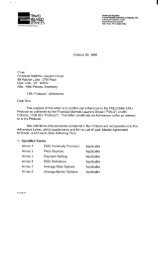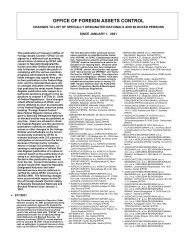Residential Foreclosures in the City of Buffalo, 1990-2000 - Federal ...
Residential Foreclosures in the City of Buffalo, 1990-2000 - Federal ...
Residential Foreclosures in the City of Buffalo, 1990-2000 - Federal ...
You also want an ePaper? Increase the reach of your titles
YUMPU automatically turns print PDFs into web optimized ePapers that Google loves.
tracts. <strong>Foreclosures</strong> were clearly both more prevalent and more likely to occur <strong>in</strong> higher<br />
<strong>in</strong>come tracts than <strong>in</strong> lower <strong>in</strong>come ones.<br />
Table 4<br />
<strong>Foreclosures</strong> by Income Status and Change<br />
This f<strong>in</strong>d<strong>in</strong>g suggests that <strong>the</strong>re may be a tipp<strong>in</strong>g po<strong>in</strong>t beyond which <strong>the</strong><br />
correlation between <strong>in</strong>come change and foreclosure becomes significant (Table 4). In<br />
o<strong>the</strong>r words, it appears that rapid <strong>in</strong>come change is <strong>the</strong> important factor <strong>in</strong> <strong>the</strong> association<br />
with foreclosure, ra<strong>the</strong>r than <strong>in</strong>come change alone. The relationship between foreclosure<br />
and <strong>in</strong>come change is not evident except <strong>in</strong> census tracts that experienced more than a 20<br />
percent decl<strong>in</strong>e <strong>in</strong> median household <strong>in</strong>come. These tracts had a foreclosure rate <strong>of</strong> 0.71<br />
percent. Thus, while foreclosure was more likely to occur <strong>in</strong> higher <strong>in</strong>come census tracts<br />
than <strong>in</strong> lower <strong>in</strong>come tracts, it was also more likely to occur <strong>in</strong> tracts that had experienced<br />
a significant decl<strong>in</strong>e <strong>in</strong> <strong>in</strong>come than <strong>in</strong> tracts that had witnessed little or no change.<br />
<strong>Foreclosures</strong> by M<strong>in</strong>ority Status<br />
To observe <strong>the</strong> relationship between foreclosures and m<strong>in</strong>ority status, we categorize<br />
foreclosures <strong>in</strong> <strong>2000</strong> by m<strong>in</strong>ority concentrations based on census tracts. As noted, we<br />
consider all non-whites and whites <strong>of</strong> Hispanic orig<strong>in</strong> to be m<strong>in</strong>orities. A census tract is<br />
categorized as m<strong>in</strong>ority if more than 50 percent <strong>of</strong> its population falls under <strong>the</strong><br />
23<br />
Census<br />
Tracts <strong>Foreclosures</strong><br />
Foreclosure<br />
Rate<br />
(Percent) (1)<br />
Percentage <strong>of</strong><br />
<strong>Foreclosures</strong><br />
Income status and change<br />
Stable lower <strong>in</strong>come (< city median) 39 290 0.44 37<br />
Changed to lower <strong>in</strong>come 6 30 0.37 4<br />
Changed to higher <strong>in</strong>come (> city median) 4 7 0.38 1<br />
Stable higher <strong>in</strong>come 38 451 0.64 58<br />
Rate <strong>of</strong> <strong>in</strong>come change<br />
Large decl<strong>in</strong>e (>20 percentage po<strong>in</strong>ts) 10 121 0.71 16<br />
Small decl<strong>in</strong>e (>10 to 20 percentage po<strong>in</strong>ts) 13 107 0.44 14<br />
No significant change (10 percentage po<strong>in</strong>ts) 17 77 0.40 10<br />
Sources: U.S. Department <strong>of</strong> Commerce, Bureau <strong>of</strong> <strong>the</strong> Census, "Census <strong>of</strong> Population and Hous<strong>in</strong>g;"<br />
<strong>Buffalo</strong> Law Journal; author's calculations.<br />
(1) The foreclosure rate is foreclosures per hous<strong>in</strong>g unit.



